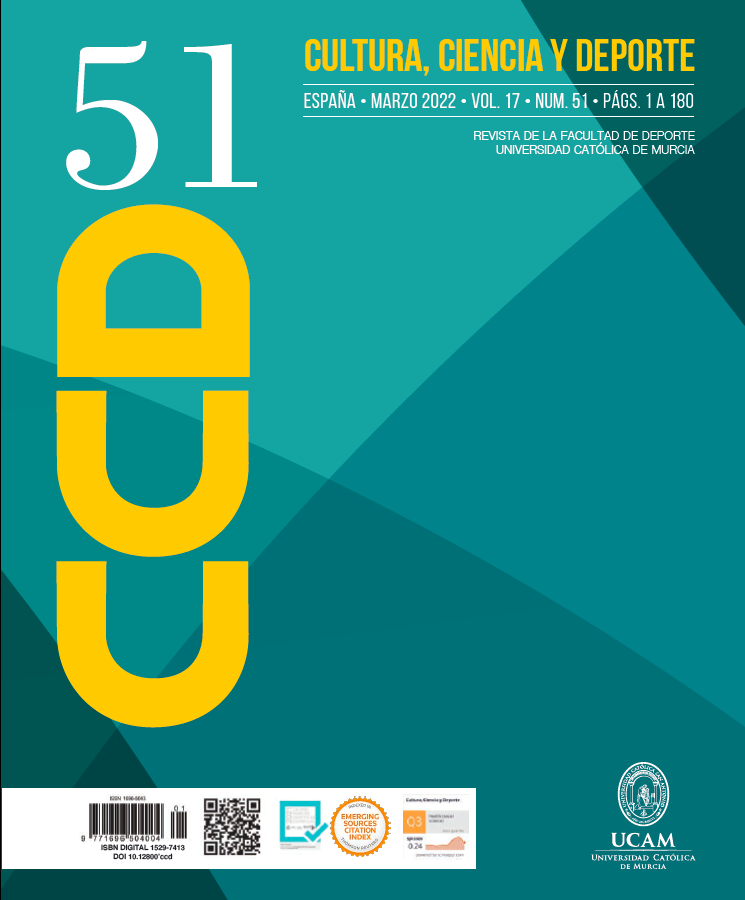Physical activity and fitness on executive funstions and academic performance in children. A systematic review.
DOI:
https://doi.org/10.12800/ccd.v17i51.1699Keywords:
Physical performance, executive functions, academic performance, school-aged childrenAbstract
This systematic review sought to investigate the influence of physical activity and physical fitness on cognitive functions. Studies were identified in four databases from January 2008 through January 2019. A total of 26 studies were selected after meeting the established criteria. Nine studies showed an association between physical activity and physical fitness variables and academic performance. Cardiorespiratory fitness, speed-agility, motor coordination, and perceptual-motor skill had the strongest association with executive function, including attention, memory, inhibition and shifting in 17 studies. High levels of physical activity and physical fitness are associated with higher academic performance and executive function. More hours of Physical Education are needed to more effectively develop the cognitive aspects and physical fitness of children in elementary school.References
Ahn, S., & Fedewa, A. L. (2011). A meta-analysis of the relationship between children’s physical activity and mental health. Journal of Pediatric Psychology, 36(4), 385–397. https://doi.org/10.1093/jpepsy/jsq107
Álvarez-Bueno, C., Pesce, C., Cavero-Redondo, I., Sánchez-López, M., Martínez-Hortelano, J. A., & Martínez-Vizcaíno, V. (2017). The Effect of Physical Activity Interventions on Children’s Cognition and Metacognition: A Systematic Review and Meta-Analysis. In Journal of the American Academy of Child and Adolescent Psychiatry. https://doi.org/10.1016/j.jaac.2017.06.012
Anderson, P. (2002). Assessment and Development of Executive Function (EF) During Childhood. Child Neuropsychology, 8(2), 71–82. https://doi.org/10.1076/chin.8.2.71.8724
Berrios Aguayo, B., Pantoja Vallejo, A., & Latorre Román, P. Á. (2019). Acute effect of two different physical education classes on memory in children school-age. Cognitive Development. https://doi.org/10.1016/j.cogdev.2019.03.004
Best, J. R. (2010). Effects of physical activity on children’s executive function: Contributions of experimental research on aerobic exercise. Developmental Review, 30(4), 331–351. https://doi.org/10.1016/j.dr.2010.08.001
Budde, H., Voelcker-Rehage, C., Pietraßyk-Kendziorra, S., Ribeiro, P., & Tidow, G. (2008). Acute coordinative exercise improves attentional performance in adolescents. Neuroscience Letters, 441(2), 219–223. https://doi.org/10.1016/j.neulet.2008.06.024
Chaddock, L., Pontifex, M. B., Hillman, C. H., & Kramer, A. F. (2011). A review of the relation of aerobic fitness and physical activity to brain structure and function in children. Journal of the International Neuropsychological Society : JINS, 17(6), 975–985. https://doi.org/10.1017/S1355617711000567
Chang, Y. K., Labban, J. D., Gapin, J. I., & Etnier, J. L. (2012). The effects of acute exercise on cognitive performance: A meta-analysis. In Brain Research (Vol. 1453, pp. 87–101). https://doi.org/10.1016/j.brainres.2012.02.068
de Greeff, J. W., Hartman, E., Mullender-Wijnsma, M. J., Bosker, R. J., Doolaard, S., & Visscher, C. (2016). Long-term effects of physically active academic lessons on physical fitness and executive functions in primary school children. Health Education Research, 31(2), 185–194. https://doi.org/10.1093/her/cyv102
Domínguez, A., Díaz-Pereira, M. P., & Martínez-Vidal, A. (2015). The evolution of motor creativity during primary education.
Donnelly, J. E., Greene, J. L., Gibson, C. A., Sullivan, D. K., Hansen, D. M., Hillman, C. H., Poggio, J., Mayo, M. S., Smith, B. K., Lambourne, K., Herrmann, S. D., Scudder, M., Betts, J. L., Honas, J. J., & Washburn, R. A. (2013). Physical activity and academic achievement across the curriculum (A + PAAC): rationale and design of a 3-year, cluster-randomized trial. BMC Public Health, 13(1), 307. https://doi.org/10.1186/1471-2458-13-307
Donnelly, J. E., Hillman, C. H., Castelli, D., Etnier, J. L., Lee, S., Tomporowski, P., Lambourne, K., & Szabo-Reed, A. N. (2016). Physical activity, fitness, cognitive function, and academic achievement in children: A systematic review. In Medicine and Science in Sports and Exercise (Vol. 48, Issue 6, pp. 1197–1222). https://doi.org/10.1249/MSS.0000000000000901
Downs, S. H., & Black, N. (1998). The feasibility of creating a checklist for the assessment of the methodological quality both of randomised and non-randomised studies of health care interventions. J Epidemiol Community Health, 52, 377–384.
Ellemberg, D., & St-Louis-Deschênes, M. (2010). The effect of acute physical exercise on cognitive function during development. Psychology of Sport and Exercise, 11(2), 122–126. https://doi.org/10.1016/j.psychsport.2009.09.006
Erwin, H., Fedewa, A., & Ahn, S. (2012). Student academic performance outcomes of a classroom physical activity intervention: A pilot study. International Electronic Journal of Elementary Education, 4(3), 473–487.
Fisher, A., Boyle, J. M. E., Paton, J. Y., Tomporowski, P., Watson, C., McColl, J. H., & Reilly, J. J. (2011). Effects of a physical education intervention on cognitive function in young children: randomized controlled pilot study. BMC Pediatrics, 11(1), 97. https://doi.org/10.1186/1471-2431-11-97
Friedman, N. P., Miyake, A., Young, S. E., DeFries, J. C., Corley, R. P., & Hewitt, J. K. (2008). Individual differences in executive functions are almost entirely genetic in origin. Journal of Experimental Psychology: General, 137(2), 201–225. https://doi.org/10.1037/0096-3445.137.2.201
Gallotta, M. C., Emerenziani, G. P., Franciosi, E., Meucci, M., Guidetti, L., & Baldari, C. (2015a). Acute physical activity and delayed attention in primary school students. Scandinavian Journal of Medicine & Science in Sports, 25(3), e331-8. https://doi.org/10.1111/sms.12310
Gallotta, M. C., Emerenziani, G. P., Franciosi, E., Meucci, M., Guidetti, L., & Baldari, C. (2015b). Acute physical activity and delayed attention in primary school students. Scandinavian Journal of Medicine & Science in Sports, 25(3), e331–e338. https://doi.org/10.1111/sms.12310
García-Pinillos, F., Soto-Hermoso, V. M., & Latorre-Román, P. A. (2016). How does high-intensity intermittent training affect recreational endurance runners? Acute and chronic adaptations: A systematic review. Journal of Sport and Health Science. https://doi.org/10.1016/j.jshs.2016.08.010
Gunnell, K. E., Poitras, V. J., LeBlanc, A., Schibli, K., Barbeau, K., Hedayati, N., Ponitfex, M. B., Goldfield, G. S., Dunlap, C., Lehan, E., & Tremblay, M. S. (2019). Physical activity and brain structure, brain function, and cognition in children and youth: A systematic review of randomized controlled trials. Mental Health and Physical Activity. https://doi.org/10.1016/j.mhpa.2018.11.002
Haapala, E. A., Poikkeus, A.-M., Tompuri, T., Kukkonen-Harjula, K., Leppänen, P. H. T., Lindi, V., & Lakka, T. A. (2014). Associations of motor and cardiovascular performance with academic skills in children. Medicine and Science in Sports and Exercise, 46(5), 1016–1024. https://doi.org/10.1249/MSS.0000000000000186
Hansen, D. M., Herrmann, S. D., Lambourne, K., Lee, J., & Donnelly, J. E. (2014). Linear/nonlinear relations of activity and fitness with children’s academic achievement. Medicine and Science in Sports and Exercise, 46(12), 2279–2285. https://doi.org/10.1249/MSS.0000000000000362
Higgins, J. P. T., & Green, S. (2011). Manual Cochrane de revisiones sistemáticas de intervenciones.
Hillman, C. H., Buck, S. M., Themanson, J. R., Pontifex, M. B., & Castelli, D. M. (2009). Aerobic fitness and cognitive development: Event-related brain potential and task performance indices of executive control in preadolescent children. Developmental Psychology, 45(1), 114–129. https://doi.org/10.1037/a0014437
Hillman, C. H., Pontifex, M. B., Castelli, D. M., Khan, N. A., Raine, L. B., Scudder, M. R., Drollette, E. S., Moore, R. D., Wu, C.-T., & Kamijo, K. (2014). Effects of the FITKids randomized controlled trial on executive control and brain function. Pediatrics, 134(4), e1063-71. https://doi.org/10.1542/peds.2013-3219
Jäger, K., Schmidt, M., Conzelmann, A., & Roebers, C. M. (2015). The effects of qualitatively different acute physical activity interventions in real-world settings on executive functions in preadolescent children. Mental Health and Physical Activity, 9, 1–9. https://doi.org/10.1016/j.mhpa.2015.05.002
Jansen, P., Scheer, C., & Zayed, K. (2019). Motor ability and working memory in Omani and German primary school-aged children. PLOS ONE, 14(1), e0209848. https://doi.org/10.1371/journal.pone.0209848
Janssen, I., & Leblanc, A. G. (2010). Systematic review of the health benefits of physical activity and fitness in school-aged children and youth. Int J Behav Nutr Phys Act., 7(1479–5868), 40. https://doi.org/1479-5868-7-40 [pii]r10.1186/1479-5868-7-40
Käll, L. B., Nilsson, M., & Lindén, T. (2014). The Impact of a Physical Activity Intervention Program on Academic Achievement in a Swedish Elementary School Setting. Journal of School Health, 84(8), 473–480. https://doi.org/10.1111/josh.12179
Kamijo, K., Pontifex, M. B., O’Leary, K. C., Scudder, M. R., Wu, C.-T., Castelli, D. M., & Hillman, C. H. (2011a). The effects of an afterschool physical activity program on working memory in preadolescent children. Developmental Science, 14(5), 1046–1058. https://doi.org/10.1111/j.1467-7687.2011.01054.x
Kamijo, K., Pontifex, M. B., O’Leary, K. C., Scudder, M. R., Wu, C.-T., Castelli, D. M., & Hillman, C. H. (2011b). The effects of an afterschool physical activity program on working memory in preadolescent children. Developmental Science, 14(5), 1046–1058. https://doi.org/10.1111/j.1467-7687.2011.01054.x
Kibbe, D. L., Hackett, J., Hurley, M., McFarland, A., Schubert, K. G., Schultz, A., & Harris, S. (2011). Ten Years of TAKE 10!(®): Integrating physical activity with academic concepts in elementary school classrooms. Preventive Medicine, 52 Suppl 1, S43-50. https://doi.org/10.1016/j.ypmed.2011.01.025
Kvalø, S. E., Bru, E., Brønnick, K., & Dyrstad, S. M. (2017). Does increased physical activity in school affect children’s executive function and aerobic fitness? Scandinavian Journal of Medicine & Science in Sports, 27(12), 1833–1841. https://doi.org/10.1111/sms.12856
Lambourne, K., Hansen, D. M., Szabo, A. N., Lee, J., Herrmann, S. D., & Donnelly, J. E. (2013). Indirect and direct relations between aerobic fitness, physical activity, and academic achievement in elementary school students. Mental Health and Physical Activity, 6(3), 165–171. https://doi.org/10.1016/j.mhpa.2013.06.002
Latorre-Román, P. Á., Mora-López, D., & García-Pinillos, F. (2016). Intellectual maturity and physical fitness in preschool children. Pediatrics International, 58(6), 450–455. https://doi.org/10.1111/ped.12898
Latorre Román, P. Á., Pinillos, F. G., Pantoja Vallejo, A., & Berrios Aguayo, B. (2017). Creativity and physical fitness in primary school-aged children. Pediatrics International, 59(11), 1194–1199. https://doi.org/10.1111/ped.13391
Lees, C., & Hopkins, J. (2013). Effect of aerobic exercise on cognition, academic achievement, and psychosocial function in children: a systematic review of randomized control trials. Preventing Chronic Disease, 10, E174. https://doi.org/10.5888/pcd10.130010
Lezak, M. D., Howieson, D. B., & Loring, D. W. (2004). Neuropsychological assessment. Oxford University Press.
Lind, R. R., Geertsen, S. S., Ørntoft, C., Madsen, M., Larsen, M. N., Dvorak, J., Ritz, C., & Krustrup, P. (2018). Improved cognitive performance in preadolescent Danish children after the school-based physical activity programme “FIFA 11 for Health” for Europe. A cluster-randomised controlled trial. European Journal of Sport Science, 18(1), 130–139. https://doi.org/10.1080/17461391.2017.1394369
Ma, J. K., Le Mare, L., & Gurd, B. J. (2015). Four minutes of in-class high-intensity interval activity improves selective attention in 9- to 11-year olds. Applied Physiology, Nutrition, and Metabolism, 40(3), 238–244. https://doi.org/10.1139/apnm-2014-0309
Mahar, M. T. (2011). Impact of short bouts of physical activity on attention-to-task in elementary school children. Preventive Medicine, 52, S60–S64. https://doi.org/10.1016/j.ypmed.2011.01.026
Mahar, M. T., Murphy, S. K., Rowe, D. A., Golden, J., Shields, A. T., & Raedeke, T. D. (2006). Effects of a classroom-based program on physical activity and on-task behavior. Medicine and Science in Sports and Exercise, 38(12), 2086–2094. https://doi.org/10.1249/01.mss.0000235359.16685.a3
Maher, C. G., Sherrington, C., Herbert, R. D., Moseley, A. M., & Elkins, M. (2003). Reliability of the PEDro scale for rating quality of randomized controlled trials. Physical Therapy, 83(8), 713–721.
Marques, A., Santos, D. A., Hillman, C. H., & Sardinha, L. B. (2018). How does academic achievement relate to cardiorespiratory fitness, self-reported physical activity and objectively reported physical activity: A systematic review in children and adolescents aged 6-18 years. British Journal of Sports Medicine, 52(16), 1039. https://doi.org/10.1136/bjsports-2016-097361
Moher, D., Liberati, A., Tetzlaff, J., Altman, D. G., & PRISMA Group. (2009). Preferred Reporting Items for Systematic Reviews and Meta-Analyses: The PRISMA Statement. PLoS Medicine, 6(7), e1000097. https://doi.org/10.1371/journal.pmed.1000097
Mullender-Wijnsma, M. J., Hartman, E., de Greeff, J. W., Bosker, R. J., Doolaard, S., & Visscher, C. (2015). Improving Academic Performance of School-Age Children by Physical Activity in the Classroom: 1-Year Program Evaluation. Journal of School Health, 85(6), 365–371. https://doi.org/10.1111/josh.12259
Ou, F. K., Wegner, M., Niemann, C., & Budde, H. (n.d.). Effects of Motor versus Cardiovascular Exercise Training on Children_s Working Memory. https://doi.org/10.1249/MSS.0000000000000869
Pesce, C., Crova, C., Cereatti, L., Casella, R., & Bellucci, M. (2009). Physical activity and mental performance in preadolescents: Effects of acute exercise on free-recall memory. Mental Health and Physical Activity, 2, 16–22. https://doi.org/10.1016/j.mhpa.2009.02.001
Pirrie, A. M., & Lodewyk, K. R. (2012). Investigating links between moderate-to-vigorous physical activity and cognitive performance in elementary school students. Mental Health and Physical Activity, 5(1), 93–98. https://doi.org/10.1016/j.mhpa.2012.04.001
Pontifex, M. B., Scudder, M. R., Drollette, E. S., & Hillman, C. H. (2012). Fit and vigilant: the relationship between poorer aerobic fitness and failures in sustained attention during preadolescence. Neuropsychology, 26(4), 407–413. https://doi.org/10.1037/a0028795
Raine, L. B., Lee, H. K., Saliba, B. J., Chaddock-Heyman, L., Hillman, C. H., & Kramer, A. F. (2013). The Influence of Childhood Aerobic Fitness on Learning and Memory. PLoS ONE, 8(9), e72666. https://doi.org/10.1371/journal.pone.0072666
Resaland, G. K., Moe, V. F., Aadland, E., Steene-Johannessen, J., Glosvik, Ø., Andersen, J. R., Kvalheim, O. M., McKay, H. A., Anderssen, S. A., & ASK study group. (2015). Active Smarter Kids (ASK): Rationale and design of a cluster-randomized controlled trial investigating the effects of daily physical activity on children’s academic performance and risk factors for non-communicable diseases. BMC Public Health, 15(1), 709. https://doi.org/10.1186/s12889-015-2049-y
Ruiz-Ariza, A., Grao-Cruces, A., de Loureiro, N. E. M., & Martínez-López, E. J. (2017). Influence of physical fitness on cognitive and academic performance in adolescents: A systematic review from 2005–2015. International Review of Sport and Exercise Psychology, 10(1), 108–133. https://doi.org/10.1080/1750984X.2016.1184699
Sardinha, L. S., Marques, A., Minderico, C., Nio Palmeira, A., Martins, S., Santos, D. A., & Ekelund, U. (2016). Longitudinal Relationship between Cardiorespiratory Fitness and Academic Achievement. Med . Sci . Sports Exerc, 48(5), 839–844. https://doi.org/10.1249/MSS.0000000000000830
Schmidt, M., Egger, F., Benzing, V., Jäger, K., Conzelmann, A., Roebers, C. M., & Pesce, C. (2017). Disentangling the relationship between children’s motor ability, executive function and academic achievement. PLOS ONE, 12(8), e0182845. https://doi.org/10.1371/journal.pone.0182845
Schmidt, M., Jäger, K., Egger, F., Roebers, C. M., & Conzelmann, A. (2015). Cognitively Engaging Chronic Physical Activity, but Not Aerobic Exercise, Affects Executive Functions in Primary School Children: A Group-Randomized Controlled Trial. Journal of Sport and Exercise Psychology, 37(6), 575–591. https://doi.org/10.1123/jsep.2015-0069
Soga, K., Shishido, T., & Nagatomi, R. (2015). Executive function during and after acute moderate aerobic exercise in adolescents. Psychology of Sport and Exercise, 16, 7–17. https://doi.org/10.1016/j.psychsport.2014.08.010
Syväoja, H. J., Tammelin, T. H., Ahonen, T., Kankaanpää, A., & Kantomaa, M. T. (2014). The Associations of Objectively Measured Physical Activity and Sedentary Time with Cognitive Functions in School-Aged Children. PLoS ONE, 9(7), e103559. https://doi.org/10.1371/journal.pone.0103559
Tomporowski, P. D., Davis, C. L., Miller, P. H., & Naglieri, J. A. (2008). Exercise and children’s intelligence, cognition, and academic achievement. Educational Psychology Review, 20(2), 111–131. https://doi.org/10.1007/s10648-007-9057-0
Trudeau, F., & Shephard, R. J. (2008). Physical education, school physical activity, school sports and academic performance. In International Journal of Behavioral Nutrition and Physical Activity (Vol. 5, Issue 1, p. 10). https://doi.org/10.1186/1479-5868-5-10
van den Berg, V., Saliasi, E., de Groot, R. H. M., Jolles, J., Chinapaw, M. J. M., & Singh, A. S. (2016). Physical Activity in the School Setting: Cognitive Performance Is Not Affected by Three Different Types of Acute Exercise. Frontiers in Psychology, 7, 723. https://doi.org/10.3389/fpsyg.2016.00723
van der Niet, A. G., Smith, J., Scherder, E. J. A., Oosterlaan, J., Hartman, E., & Visscher, C. (2015). Associations between daily physical activity and executive functioning in primary school-aged children. Journal of Science and Medicine in Sport, 18(6), 673–677. https://doi.org/10.1016/j.jsams.2014.09.006
Verburgh, L., Königs, M., Scherder, E. J. a, & Oosterlaan, J. (2014). Physical exercise and executive functions in preadolescent children, adolescents and young adults: a meta-analysis. British Journal of Sports Medicine, 48(12), 973–979. https://doi.org/10.1136/bjsports-2012-091441
Wittberg, R. A., Northrup, K. L., & Cottrell, L. A. (2012a). Children’s aerobic fitness and academic achievement: a longitudinal examination of students during their fifth and seventh grade years. American Journal of Public Health, 102(12), 2303–2307. https://doi.org/10.2105/AJPH.2011.300515
Wittberg, R. A., Northrup, K. L., & Cottrell, L. A. (2012b). Children’s Aerobic Fitness and Academic Achievement: A Longitudinal Examination of Students During Their Fifth and Seventh Grade Years. American Journal of Public Health, 102(12), 2303–2307. https://doi.org/10.2105/AJPH.2011.300515
Yanagisawa, H., Dan, I., Tsuzuki, D., Kato, M., Okamoto, M., Kyutoku, Y., & Soya, H. (2010). Acute moderate exercise elicits increased dorsolateral prefrontal activation and improves cognitive performance with Stroop test. NeuroImage, 50(4), 1702–1710. https://doi.org/10.1016/j.neuroimage.2009.12.023
Published
Versions
- 2022-02-28 (2)
- 2022-02-18 (1)
How to Cite
Issue
Section
License
Copyright (c) 2022 Creative Commons Attribution License

This work is licensed under a Creative Commons Attribution-NonCommercial-ShareAlike 4.0 International License.
The authors who publish in this journal agree with the following terms:
- The authors retain the copyright and guarantee the journal the right to be the first publication of the work as well as licensed under a Creative Commons Attribution License that allows others to share the work with recognition of the authorship of the work and the initial publication in this journal.















